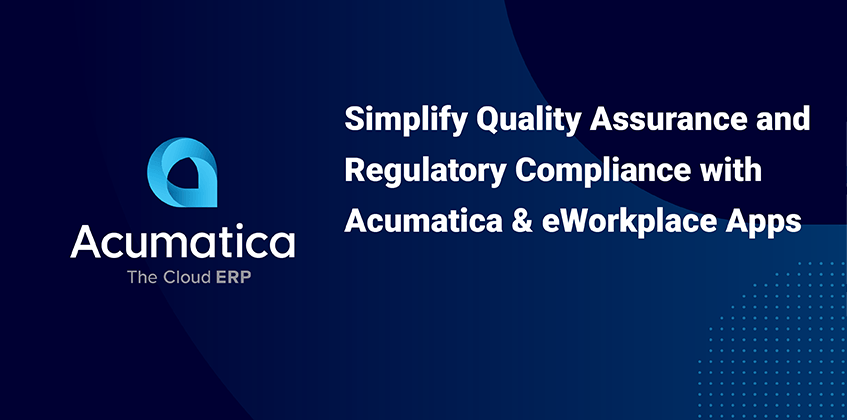
Manufacturers, distributors, and retailers have very complex businesses requirements—juggling supply chain operations, inventory management, production and design factors, customer relationship considerations, and much more. Just managing these daily tasks is a challenge. But it becomes even more difficult when federal and industry-specific quality and compliance regulations are thrown into the mix.
Producing and distributing quality products while running a legally compliant, trustworthy business is paramount for ensuring customer safety, growing a base of satisfied customers, and forging a good brand reputation. But compliance regulations can force manufacturers and distributors to further complicate processes—like audits and document changes—which could otherwise be much easier.
How can manufacturers, distributors, and retailers manage the hundreds of thousands of regulations and restrictions they face? How can they keep up with external rules and internal operations at the same time—without losing track of either?
Today, we’ll talk about the three clear steps to quality assurance and regulatory compliance:
- Knowing what regulations apply to your business
- Connecting your business processes to data
- Equipping your business with the right technology
1. Knowing What Regulations Apply To Your Business
Manufacturers, distributors, and retailers face six main categories of quality and compliance regulations—all with their own levels and sublevels of complexity.
- Business and Finance: In addition to overall tax compliance, these include the International Financial Reporting Standards (IFRS), Generally Accepted Accounting Principles (GAAP), and the Sarbanes-Oxley Act (SOX), which requires publicly-traded companies to adopt rigorous internal procedures for accurate financial statements.
- Information Technology: IT regulations cover many different categories, including PCI security standards for processing payments; ISO 27001 cybersecurity standards; the US CAN-SPAM Act, which sets the rules for commercial emails; the General Data Protection Regulation (GDPR), which governs the processing of personal data; FedRAMP, which helps secure cloud services; and the SOC, SSAE, and ISAE regulations from the American Institute of Certified Public Accountants (AICPA).
- Industry Restrictions: While the International Organization for Standardization (ISO) sets global standards for trusted goods and services, industry-specific regulations are also developed by independent groups, such as the Automotive Industry Action Group (AIAG), the American National Standards Institute (ANSI), ASTM International (for materials and testing), and SAE International (for automotive and aerospace regulations).
- Labor Laws: Alongside workers’ compensation laws, these include Occupational Safety and Health Administration (OSHA) regulations, the Health Insurance Portability and Accountability Act (HIPPA), the Fair Labor Standards Act, and the Family and Medical Leave Act (FMLA).
- Trading Partner Compliance: Customers and vendors may set their own restrictions for quality, including EDI requirements for electronic document transmittal, labeling and packaging specifications, product quality standards, and more.
- Other Government Regulations: These vary according to location, but, in the US, they include regulations set by the Environmental Protection Agency (EPA), the Food and Drug Administration (FDA), the Federal Trade Commission (FTC), and The Consumer Product Safety Commission (CPSC).
Of course, not all of these regulations apply to every business. They vary according to industry, location, and business type. It is critical to do your research and know beforehand which requirements you are expected to keep—and which optional standards you want to follow to further establish your business as a trustworthy partner.
But, after you’ve established what these regulations are, how do you actually go about following them? Actionable data is the key to regulatory compliance.
2. Connecting Business Processes to Data
As your manufacturing, distribution, or retail business rolls forward, it is constantly producing data. That data can be harnessed in six important ways to help your company maintain regulatory compliance across the board. You’ll need to think about:
- Documentation: Document your standard operating procedures, work instructions, safety protocols, and compliance requirements.
- Training: Manage employee skills and certifications; recertify/train employees as needed.
- Accuracy: Capture product quality test results and ensure that all reports are accurate.
- Reporting: Use these accurate reports to evaluate vendor performance, machine downtime, and more.
- Security: Use multiple levels of security to protect the integrity of your data and avoid cyberattacks.
- Process Control: Track change requests, establish standards for configured products, and keep those standards linked to the products.
Feels complicated, doesn’t it?
That’s because it would be—if you were going about it manually. In fact, it wouldn’t just be complicated. It would be impossible. Which brings us to step three.
3. Equipping Your Business with the Right Technology
The complexities of knowing what regulations apply to your business, complying with these rules, and connecting business processes to data underscore the importance of equipping your business with the right technology. Implementing modern business management technology is the only way to connect your business processes to actionable data and to achieve quality assurance and regulatory compliance.
How do you know which technology is right for your business?
You look for a system that can truly simplify the processes listed above: documentation, training, accuracy, reporting, security, and process control.
These benefits can be found in a modern enterprise resource planning (ERP) system, like Acumatica, combined with a future-focused Quality Management System (QMS), like eWorkplace Apps (EWPA) QMS.
With Acumatica Cloud ERP, companies can easily use wikis to document standard operating procedures, work instructions, and safety protocols and to manage quality documentation requirements with embedded document management. EWPA QMS extends these core abilities, empowering users to fully control and streamline their internal quality and compliance needs.
You can use the custom attributes in Acumatica’s employee file to manage employee skills and certifications. Embedded CRM features can also be applied to create tasks for recertification and training.
Acumatica’s barcoding, artificial intelligence, and machine learning eliminate human error, improving data accuracy. This ERP data can be connected to external data with flexible inquiries and live dashboards, so you can easily evaluate vendor performance, machine downtime, and more.
EWPA QMS is built to manage testing and recall, inspections and checklists, calibration, non-conformance (NC), Corrective and Preventative Actions (CAPA), root cause analysis, forward and backward traceability reporting, certificates of analysis, quality data collection, vendor performance analysis, and much more. This means you’ll always be operating with powerful, accurate reports and data at your fingertips.
Acumatica’s multiple levels of security also protect the integrity of your data and prevent cyberattacks. Built-in role-based security provides internal controls to limit access to information, so employees can only see the information they’re authorized to see.
Automated business processes with Acumatica and EWPA eliminate data entry errors. Engineering change control and connected product lifecycle management apps track change requests with audit logs. And you can apply Acumatica’s rules-based product configurator to establish standards for configured products.
Quality Compliance: Simplified
Acumatica Cloud ERP and EWPA QMS are built to help you successfully navigate the almost endless sea of quality assurance and compliance regulations. Together, they take the complexities of compliance and condense them into a simple, straightforward interface that you are in full control of.
To read more about how Acumatica and EWPA streamline these processes, download our full solution brief: “Simplify Government and Industry Quality Compliance with Acumatica.”
And, if you have any other questions, contact our experts today.











